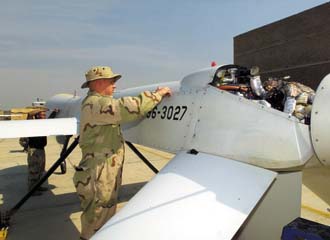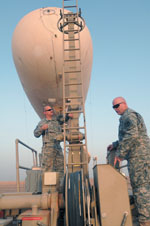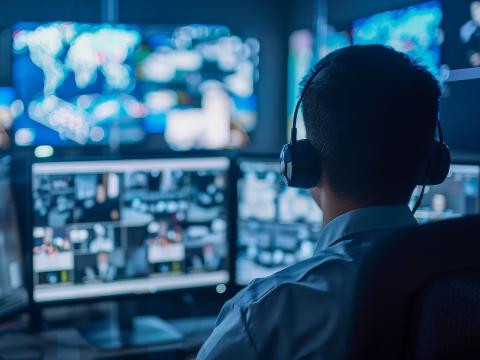 |
Airman 1st Class John D. Clark, USAF, from the 15th Reconnaissance Squadron, Nellis Air Force Base, Nevada, performs maintenance on a Predator unmanned aerial vehicle after its return from a reconnaissance flight over Afghanistan in 2003. Predators still play a major role in operations in that country, helping to support the large intelligence, surveillance and reconnaissance (ISR) need when units require more coverage than smaller assets with limited range can provide. |
Increased numbers of ground forces demand more support, flexibility. As conflict in Afghanistan intensifies, coalition allies are employing all elements of information-gathering technology to win battles while protecting themselves and civilians. Intelligence, surveillance and reconnaissance activity is at an all-time high as experts try to coordinate the largest armada of these capabilities ever deployed.
Col. Scott F. Murray, USAF, director of intelligence, surveillance and reconnaissance (ISR) at the International Security Assistance Force (ISAF) Joint Command (IJC) in Kabul, explains that ISR resources in Afghanistan are flying four times as many hours as during the height of the surge in Iraq. In terms of sorties and aircraft, he estimates three times as much usage as what occurred in Iraq. Col. Murray served in that country from July 2007 to August 2008, giving him a prime vantage point for comparing operations in the two theaters. The colonel explains that the increase in ISR usage in Afghanistan reflect more than a shifting of resources from one geographic location to another, and that emerging technology has grown the number of resources available. Aerostats (or tethered balloons), for example, are providing additional aerial coverage and putting more information into the hands of troops.
When Col. Murray arrived in Afghanistan in June of this year, he expected to find the allocation of assets managed along the same lines as those in Iraq. To his surprise, he found a much different situation. During his previous assignment, ISR resources were shared in what he calls a “peanut-butter spread” approach. Various commanders shared the platforms and knew they would have certain numbers. The benefit to that method, he explains, was that everyone got something. The downside was that for certain operations, an increase in Predators in a specific location, for example, could have benefited ground troops.
Unlike in Iraq, personnel in Afghanistan use a priority-driven system for distribution of ISR resources. When tactical commanders need capabilities available at the operational level, they request them based on a prioritized list. The ISR division then supports them as appropriate. One of the most common requests Col. Murray receives is for full-motion video that can be provided by larger platforms.
The requests come when the organic capabilities of the various groups making up the coalition force in Afghanistan lack the ability to support requirements. The colonel explains that the organic capabilities include smaller unmanned vehicles such as those users can throw or launch into the air. Because those tools operate on line-of-sight capabilities, troops can employ them only in limited geographic areas. Larger assets, such as the Predator or Warrior unmanned aerial vehicles, fall under Col. Murray’s division. When even his resources fall short of the need, he puts in requests higher up the chain for support from agencies back in the United States.
Almost four dozen countries across six regional command areas in Afghanistan are contributing to ISAF, requiring significant coordination and support. One way in which collaboration is enhanced is through mission-type orders (MTOs), which give lower units an objective but not specific details for accomplishing the goal. “MTOs allocate theater ISR to supplement a battlespace commander’s organic ISR for a specific period of time,” Col. Murray explains. “Theater ISR must support an approved operations plan.” Once the orders have been issued to tie together certain resources for particular commanders at specific times, the commanders can work with others and handle the processing, exploitation and dissemination (PED) of the data collected as they deem necessary. The Air Force retains all rights to allocate PED nodes, but once allocated, the nodes communicate directly with the supported units.
In these types of situations, and in other operations, Col. Murray has noticed a popular trend—chat. He explains that the young troops use the capability to communicate during missions. Sometimes, he says, 24 chat rooms will be open at a time. “That’s the untold story,” Col. Murray states. “This war is being fought by chat.” The method of communication is connecting people as far away from the action as the Pentagon all the way down to soldiers on the battlefield in the midst of an operation. Quick sharing has reduced the time for information to pass from sensor to shooter from minutes to seconds, according to the colonel.
Chat-room language also offers an extra layer of commonality in communication among the various nationalities involved in the coalition. Col. Murray says it is known and accepted among members of the younger generation no matter the uniform they wear. Even during their free time, this demographic of service members uses chat-speak and chat platforms to pass information. The more formal language of choice both in the chat rooms and around the IJC in general is English, because, as the colonel explains, everyone speaks it, even though approximately 40 countries are represented.
 |
Two U.S. Army aerostat blimp operators with B Troop, Regimental Troop Squadron of the Tennessee National Guard’s 278th Armored Cavalry Regiment, 103rd Sustainment Command (Expeditionary), launch a balloon at Contingency Operating Base Taji, Iraq. Aerostats also are being employed in Afghanistan to enhance ISR capabilities. |
ISAF members also are communicating better thanks to the push toward a common network. “The Afghan Mission Network is where you’d expect technology to take us,” Col. Murray states. The tool connects multinational systems together, making information sharing among different countries simpler. Col. Murray says that at the basic level it neutralizes users, meaning the system does not care who collects the information nor does it limit dissemination. “I can get it to whomever I need to get it to,” he explains.
An emerging technology proving useful in theater is wide area surveillance. This capability enables an ISR asset to employ a camera that takes in images over a radius of several kilometers. The extra coverage helps collectors and analysts cover more ground, but the capability also can zoom in on a certain area of interest. By cross-queuing data from other intelligence forms, such as signals or human, users can focus the wide area surveillance camera on a specific point to gather more information about a subject of interest.
Col. Murray warns that while many traditional intelligence-gathering means are employed in Afghanistan, “intelligence” can be a narrow word. Information often is gleaned through nontraditional means by the people operating in the country. He also explains that in Iraq, ISR was used for security measures to support ground forces often in violent situations. Though forces in Afghanistan receive support from ISR for ground battles, the assets are employed for governance and development as well. For example, a platform could be used to monitor bazaar traffic at a certain time of day, helping the boots on the ground develop an accurate picture of the flow of people and events in the area.
Another example offered by the colonel is the use of an aerostat asset to monitor developments after a traffic accident. Taliban operatives seize on such an everyday situation to inflict violence in a crowd that normally would have remained peaceful. The data from the balloon would be added to other pieces of information so decisions could be made about who should respond and how.
A challenge for ISR coordinators is finding the most effective ways to use all the resources available. Col. Murray says warfighters always can use more assets in general and more niche capabilities, but that maximizing the potential of what is currently in the field might be just as important.
The colonel explains another challenge as well—throwing people or resources at a problem without ensuring the proper support is in place. He shares that many organizations in the United States are doing a great job developing solutions to issues, but sometimes they forget to ensure that analytical pieces are ready. Col. Murray would like groups to ensure that, when they field capabilities, they establish that the background PED is prepared. PED activities include efforts both in the United States and forward in the theater.
Despite this issue, Col. Murray says that overall, from a joint perspective, he is pleased with the support he and his cohorts receive, and that he has confidence in decision makers. A piece of assistance he touts is the fielding of the Air Force’s MC-12 Liberty ISR platform, which he describes as an “incredible force multiplier” in Afghanistan. He also has praise for Dr. Ashton B. Carter, under secretary of defense for acquisition, technology and logistics, who the colonel says has done a good job listening to field commanders and helping to provide what they need.
Some of the technical challenges ISR experts must deal with in Afghanistan have less to do with insurgents than with Mother Nature. The cold and nasty weather of winter, coupled with geographic features, makes gathering information difficult even without worrying about human enemies. “There are vast regions in this country that are not conducive to ISR,” Col. Murray says. As with wide area surveillance, winter weather mitigation efforts are starting to emerge, but the colonel says the problems will not be solved this year.
Even with all the media coverage focused on events in Afghanistan, Col. Murray believes there might be facets of the war there that people outside the theater fail to understand. In general terms, he explains that the public might wonder why they hear about increased violence. The answer is that more and more troops are penetrating the places they must go to defeat the enemy. Unfortunately, the result is an uptick in direct conflict. The colonel relates an analogy used by Gen. David Petraeus, USA, the top U.S. commander in Afghanistan, in which the general compares current events in Afghanistan to a statement by 1920s bank robber Willie Sutton. When asked why he robbed banks, Sutton replied, “Because that’s where the money is.” To secure Afghanistan, coalition forces must engage in the locations where the enemy resides. “It’s where people are violent,” Col. Murray explains.
Outside Afghanistan, people also might have misperceptions about ISR, according to the colonel. Rather than a static operation involving the collection of hundreds of hours of video and examination of still photographs, professionals and assets are actively engaged in supporting a fighting force. Collectors and analysts work to put the right resources where commanders need them through a fair and detailed process. “It’s hard to do,” he says.
ISR in theater is being used in reaction to what ground commanders need on specific days, not to an inflexible schedule. For example, in September assets were re-arranged to help find a missing U.K. citizen, and earlier in the year they were diverted to help search for missing U.S. service members. “Most of the time in the ISR world the plan doesn’t survive,” Col. Murray explains. In addition to enemy actions, activities such as large events, maintenance and weather affect the distributions of resources. Those in charge of ISR allocation adapt to fit the needs of the boots on the ground.
WEB RESOURCES
International Security Assistance Force Afghanistan: www.isaf.nato.int
MC-12 Liberty Fact Sheet: www.af.mil/information/factsheets/factsheet.asp?id=15202
Office of the Under Secretary of Defense for AT&L: www.acq.osd.mil






Comments